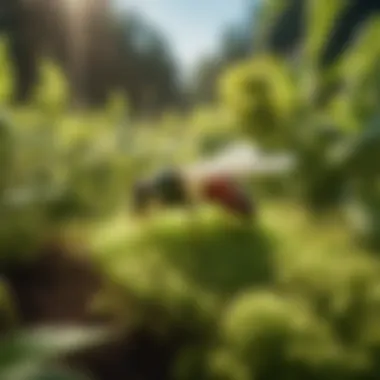Materials:
- Pesticides: 1 gallon of concentrated insecticide to cover 1 acre of land.
- Sprayer: Heavy-duty sprayer with a capacity of at least 2 gallons.
- Protective Gear: Nitrile gloves, safety goggles, and a mask for protection.
- Water Source: Sufficient water for diluting the pesticide.
DIY Steps:
- Preparation: Ensure the weather is calm and dry before application to prevent runoff.
- Mixing: Dilute the pesticide according to the manufacturer's instructions in the sprayer tank.
- Application: Begin spraying from the far end of the area, moving towards yourself in parallel lines.
- Wait: Allow time for the pesticide to dry before allowing pets or children in the treated area.
Technical Aspects:
- Timing: Apply pesticides early in the morning or late in the evening for optimal results.
- Tools: A calibrated sprayer is essential to ensure even distribution of the pesticide.
DIY Project Process:


- Materials Preparation: Gather all necessary materials and put on protective gear.
- Mixing: Carefully measure and mix the pesticide following exact measurements.
- Spraying Technique: Hold the sprayer at a constant height and maintain a steady pace for uniform coverage.
- Troubleshooting Tips: If overspray occurs, use a sponge or cloth to absorb excess pesticide to prevent wastage.
Understanding Pesticides


Definition and Types of Pesticides
Insecticides
When it comes to combating insect pests, insecticides stand out as a crucial category within the realm of pesticides. Specifically formulated to target and control insect populations, insecticides play a significant role in pest management strategies. The key characteristic of insecticides lies in their ability to effectively target specific insect species while minimizing harm to non-target organisms. This selectivity makes insecticides a popular choice for bug control in agricultural and residential settings. However, it is essential to note that while insecticides offer targeted pest control, over-reliance can lead to the development of insecticide resistance.
Herbicides
Shifting focus to herbicides, these pesticides are designed to control unwanted plant growth. Herbicides target weeds that compete with crops for nutrients, sunlight, and resources, thereby enhancing crop yield and quality. The key characteristic of herbicides is their ability to selectively target and eliminate weeds while preserving the desired plants. This selective action makes herbicides a beneficial choice for weed control in various agricultural practices. However, improper application or overuse of herbicides can lead to environmental issues such as soil contamination and water pollution.
Fungicides
In the realm of plant health, fungicides play a crucial role in combating fungal diseases that can devastate crops. Fungicides are formulated to inhibit the growth and spread of fungi, thereby protecting plants from diseases that can impact their growth and yield. The key characteristic of fungicides lies in their preventive and curative properties against fungal pathogens, making them an essential tool in disease management strategies. While fungicides offer effective protection against fungal diseases, frequent use can lead to the development of resistance in fungal populations, necessitating judicious application to maintain efficacy.
Mode of Action of Pesticides
Contact
One of the primary modes of action for pesticides is contact, wherein the pesticide exerts its effects upon direct contact with the target organism. Contact pesticides act swiftly upon contact, disrupting vital physiological processes and ultimately leading to the insect's demise. The key characteristic of contact pesticides is their immediate impact, making them a popular choice for controlling fast-moving pests. However, contact pesticides may require reapplication to maintain efficacy, especially in outdoor settings where environmental factors can influence their longevity.
Ingested
Ingested pesticides are designed to be consumed by the target organism, thereby delivering the active ingredients internally for effective pest control. Upon ingestion, these pesticides target specific physiological systems within the insect, disrupting vital functions and causing mortality. The key characteristic of ingested pesticides is their systemic nature, providing long-lasting protection against pests that feed on treated plants. However, the prolonged residual activity of ingested pesticides raises concerns about potential toxicity to non-target organisms and environmental persistence.
Systemic
Systemic pesticides are absorbed by plants and distributed throughout their tissues, offering internal protection against pests that feed on various plant parts. By moving systemically within the plant, these pesticides provide continuous pest control, even in hard-to-reach areas. The key characteristic of systemic pesticides is their ability to target pests that are challenging to reach with conventional contact sprays. However, systemic pesticides raise environmental concerns due to their persistence in the soil and potential impact on non-target organisms.
Regulation and Safety Measures
EPA Guidelines
The Environmental Protection Agency (EPA) plays a crucial role in regulating the registration, distribution, and use of pesticides in the United States. EPA guidelines outline specific requirements for pesticide registration, labeling, application, and disposal to ensure environmental and human safety. The key characteristic of EPA guidelines is their stringent regulations that aim to minimize risks associated with pesticide use while maximizing efficacy. Adhering to EPA guidelines is essential for pesticide users to mitigate potential health and environmental hazards.
Protective Gear
When handling pesticides, wearing appropriate protective gear is paramount to safeguarding personal health and minimizing exposure risks. Protective gear includes items such as gloves, goggles, respirators, and coveralls, which help prevent skin contact, inhalation, and ingestion of pesticide residues. The key characteristic of protective gear is its role in creating a physical barrier between the user and the pesticide, reducing the likelihood of adverse health effects. Proper selection and use of protective gear are critical for ensuring safety during pesticide handling and application.
Environmental Impact Assessments
Conducting environmental impact assessments (EIAs) is essential to evaluate the potential ecological consequences of pesticide use on non-target species and ecosystems. EIAs assess the direct and indirect effects of pesticides on pollinators, aquatic life, soil quality, and water resources to identify potential risks and mitigation measures. The key characteristic of EIAs is their comprehensive evaluation of pesticide impacts at various levels of the ecosystem, providing valuable insights for sustainable pesticide management practices. Integrating environmental impact assessments into pesticide decision-making processes helps minimize adverse environmental effects and protect biodiversity.
Efficacy of Pesticides


Efficacy of Pesticides is a crucial aspect to explore when delving into the impact of pesticides on insect control. Understanding the effectiveness of pesticides in managing insect populations is vital for ensuring successful pest management strategies. In this article, we focus on examining the specific elements that contribute to the efficacy of pesticides, such as their ability to target and control pest populations, the duration of their effects, and their impact on non-target species and the environment. By discussing these elements, we aim to provide readers with a comprehensive understanding of how pesticides work in insect control.
Targeted Pest Control
Selective vs. Broad-Spectrum
Selective vs. Broad-Spectrum pesticides play a significant role in targeted pest control. Selective pesticides target specific pests while leaving beneficial insects unharmed, promoting a more eco-friendly approach to pest management. In contrast, broad-spectrum pesticides target a wide range of pests, which may result in unintended harm to non-target species. The key characteristic of selective pesticides lies in their precision in targeting specific pests, reducing the overall impact on the environment. However, they may be less effective against a broader range of pests compared to broad-spectrum options. Understanding the advantages and disadvantages of selective vs. broad-spectrum pesticides is essential in choosing the most suitable option for insect control in this article.
Residual Activity
Residual activity refers to the persistence of a pesticide's effectiveness over time after application. Pesticides with high residual activity continue to control pests for an extended period, providing long-term protection to crops and properties. The key characteristic of residual activity is its ability to offer prolonged pest control, reducing the need for frequent reapplication. However, there are concerns regarding environmental impact and residue buildup with prolonged use of pesticides with high residual activity. Assessing the advantages and disadvantages of residual activity in this article is paramount in understanding its role in effective insect control.
Resistance Development
Genetic Mutations
Genetic mutations in pests can lead to resistance development against pesticides, posing challenges in pest management. Understanding the genetic mechanisms behind resistance development is crucial for adapting pest control strategies effectively. The key characteristic of genetic mutations is their role in altering pest genes to overcome the effects of pesticides, reducing their efficacy over time. While genetic mutations enable pests to survive pesticide exposure, they also raise concerns about the continuous evolution of resistant pest populations. Exploring the advantages and disadvantages of genetic mutations in the context of insect control is essential for addressing resistance development in this article.
Cross-Resistance
Cross-resistance occurs when pests develop resistance to multiple pesticides with similar modes of action. This phenomenon complicates pest management efforts as pests become resistant to various chemical interventions. The key characteristic of cross-resistance lies in its ability to confer broad resistance across pesticide classes, limiting the effectiveness of different chemical interventions. While cross-resistance challenges traditional pest control methods, it highlights the importance of diversifying pest management strategies to combat evolving pest resistance. Evaluating the advantages and disadvantages of cross-resistance in this article is crucial in devising effective pest control solutions.
Integrated Pest Management
Combining Methods
Combining different pest control methods is a fundamental strategy in integrated pest management (IPM). By integrating multiple approaches such as biological control, cultural practices, and chemical interventions, IPM seeks to enhance pest control efficacy while minimizing environmental impact. The key characteristic of combining methods is the synergistic effect achieved by integrating diverse pest management strategies, improving overall pest control outcomes. However, challenges may arise in coordinating multiple methods and ensuring their compatibility within the integrated approach. Exploring the advantages and disadvantages of combining methods in this article offers insights into the complexities and benefits of adopting integrated pest management solutions.
Reducing Pesticide Reliance
Reducing reliance on pesticides within pest management strategies is a sustainable approach aimed at minimizing chemical inputs and environmental impact. By incorporating non-chemical control methods and adopting preventative measures, reducing pesticide reliance can promote ecological balance and long-term pest control effectiveness. The key characteristic of reducing pesticide reliance lies in promoting sustainable pest management practices that prioritize natural and mechanical control measures over chemical interventions. While reducing pesticide reliance aligns with environmentally conscious practices, it may require a higher level of monitoring and intervention to maintain effective pest control. Examining the advantages and disadvantages of reducing pesticide reliance in this article emphasizes the importance of embracing holistic pest management approaches for sustainable insect control.
Environmental Concerns
In the realm of insect control, environmental concerns play a pivotal role in shaping strategies and outcomes. Addressed within this article is a deep dive into the intricate balance between pest management and ecological impact. Understanding and mitigating these concerns are paramount for sustainable bug control solutions. By exploring how pesticides affect non-target species, residue persistence, and risks to human health, this article sheds light on the broader implications of pesticide use.
Impact on Non-Target Species
Pollinators
Delicate and essential to ecosystem health, pollinators like bees, butterflies, and birds are intricately linked to insect control methods. Their pivotal role in pollination ensures food production and biodiversity. Reflecting a crucial aspect of environmental concerns, preserving pollinators is crucial for crop yields and ecosystem stability. However, the inadvertent effects of pesticides on their populations pose a threat to agricultural sustainability and biodiversity. Balancing pest management with pollinator protection becomes imperative in this context, highlighting the need for environmentally-friendly bug control measures.
Aquatic Life
The impact of pesticides on aquatic life forms a critical element of environmental considerations in insect control. From freshwater fish to microorganisms, water bodies face pollution risks from pesticide runoffs. Contaminated water sources not only harm aquatic organisms but also disrupt entire ecosystems. Understanding the unique vulnerability of aquatic life to pesticide residues underscores the importance of adopting pesticide management practices that safeguard water quality and biodiversity.
Residue Persistence
Soil Contamination
Soil contamination stemming from pesticide usage poses a multifaceted challenge in bug control. Pesticide residues leaching into soil layers can persist for extended periods, altering soil composition and impacting essential microorganisms. This disruption in the soil ecosystem can lead to reduced fertility and biodiversity loss, necessitating measures to minimize contamination risks. Implementing targeted pesticide application techniques and utilizing biopesticides can help mitigate soil contamination, ensuring sustainable agriculture practices.
Water Pollution
The threat of water pollution due to pesticide runoff is a pressing concern in bug management. Runoff from fields treated with pesticides can seep into water bodies, contaminating drinking water sources and aquatic habitats. The lasting effects of water pollution extend beyond immediate ecological impacts, affecting human health and ecosystem resilience. Promoting responsible pesticide use through awareness campaigns and embracing eco-friendly pest control alternatives are pivotal in mitigating water pollution risks.
Risk to Human Health
Exposure Effects
Understanding the nuanced impact of pesticide exposure on human health is integral to informed decision-making in bug control. Direct or indirect exposure to pesticides can lead to various health repercussions, ranging from skin irritations to respiratory issues. Minimizing exposure risks through protective gear usage, adherence to application guidelines, and opting for low-toxicity pesticides are key strategies to safeguard human health while managing insect populations.
Pesticide Drift
Pesticide drift, characterized by the unintentional movement of sprayed chemicals beyond targeted areas, raises significant concerns regarding human health and environmental safety. Inhalation of drifted pesticides or ingestion of contaminated produce poses health risks to individuals and wildlife alike. Implementing drift-reduction technologies, employing precision application methods, and enforcing buffer zones can help mitigate pesticide drift, promoting safer bug control practices and protecting human and environmental well-being.
Alternative Bug Control Methods
Alternative bug control methods play a crucial role in this article by offering sustainable and effective solutions to managing insect populations. In the realm of pest management, exploring alternative methods introduces eco-friendly approaches that reduce reliance on chemical pesticides. By delving into alternative bug control methods, this article sheds light on innovative strategies that promote environmental health and biodiversity. Readers will gain insight into the benefits of adopting diverse pest control techniques that not only target pests but also prioritize ecosystem balance and long-term sustainability.
Biological Control
Predators:
Predators, as a specific aspect of biological control, contribute significantly to the overall goal of managing insect populations naturally. An essential characteristic of predators is their ability to naturally prey on pest species, helping to regulate pest populations without the need for synthetic chemicals. Predators are a popular choice in this article due to their environmentally friendly approach and their effectiveness in controlling pest numbers in a sustainable manner. The unique feature of predators lies in their ability to specifically target pest insects, offering a targeted and selective approach to pest management. While predators contribute positively to reducing pest populations, there may be challenges in maintaining predator populations in certain environments.
Parasitoids:
Within the realm of biological control, parasitoids play a vital role in achieving the overall goal of natural pest management. The key characteristic of parasitoids is their ability to use host insects as resources for reproduction, ultimately leading to a decline in pest populations. This makes parasitoids a beneficial choice for this article as they offer a natural and effective means of pest control. A unique feature of parasitoids is their ability to specifically target certain pest species, providing a targeted solution to pest issues. While parasitoids can be advantageous in reducing pest numbers, there may be limitations in their effectiveness under certain environmental conditions.
Mechanical Control
Traps:
In the realm of mechanical control, traps play a significant role in contributing to the overall goal of managing insect populations through physical means. The key characteristic of traps is their ability to lure and capture target pests, offering a non-toxic and selective approach to pest control. Traps are a popular choice in this article because of their effectiveness in monitoring and controlling pest populations without the use of chemicals. The unique feature of traps lies in their ability to target specific pest species, providing a targeted and environmentally friendly solution to pest issues. While traps can be beneficial in reducing pest populations, there may be challenges in consistently capturing pests in large-scale operations.
Barriers:
Within mechanical control methods, barriers play a crucial role in aiding the overall objective of managing insect populations through physical obstruction. The key characteristic of barriers is their ability to create a protective shield that prevents pests from accessing food sources or breeding areas. Barriers are a beneficial choice for this article due to their non-toxic and sustainable approach to pest management. The unique feature of barriers lies in their ability to act as a barrier against pest intrusion, offering a proactive solution to pest issues. While barriers can be effective in limiting pest infestations, there may be limitations in maintaining barrier integrity over time.
Cultural Control
Crop Rotation:
Crop rotation serves as a specific aspect of cultural control, contributing significantly to the overall goal of managing insect populations through strategic agricultural practices. The key characteristic of crop rotation is its ability to disrupt pest life cycles and reduce pest pressure on specific crops. Crop rotation is a popular choice in this article because of its sustainable approach to pest management that improves soil health and reduces pest outbreaks. The unique feature of crop rotation lies in its ability to naturally suppress pest populations without relying on synthetic chemicals, offering a holistic solution to pest issues. While crop rotation can be advantageous in pest control, implementing and maintaining rotation schedules can require careful planning and monitoring.
Sanitation Practices:
Sanitation practices within cultural control methods play a vital role in achieving the overall goal of managing insect populations through maintaining clean and pest-free environments. The key characteristic of sanitation practices is their ability to eliminate pest breeding grounds and food sources, reducing pest populations naturally. Sanitation practices are a beneficial choice for this article as they offer a proactive and sustainable approach to pest management. The unique feature of sanitation practices lies in their ability to prevent pest infestations through hygiene and cleanliness, promoting long-term pest control without the need for chemicals. While sanitation practices can be effective in reducing pest numbers, consistent upkeep and vigilance are essential to maintain pest-free surroundings.





